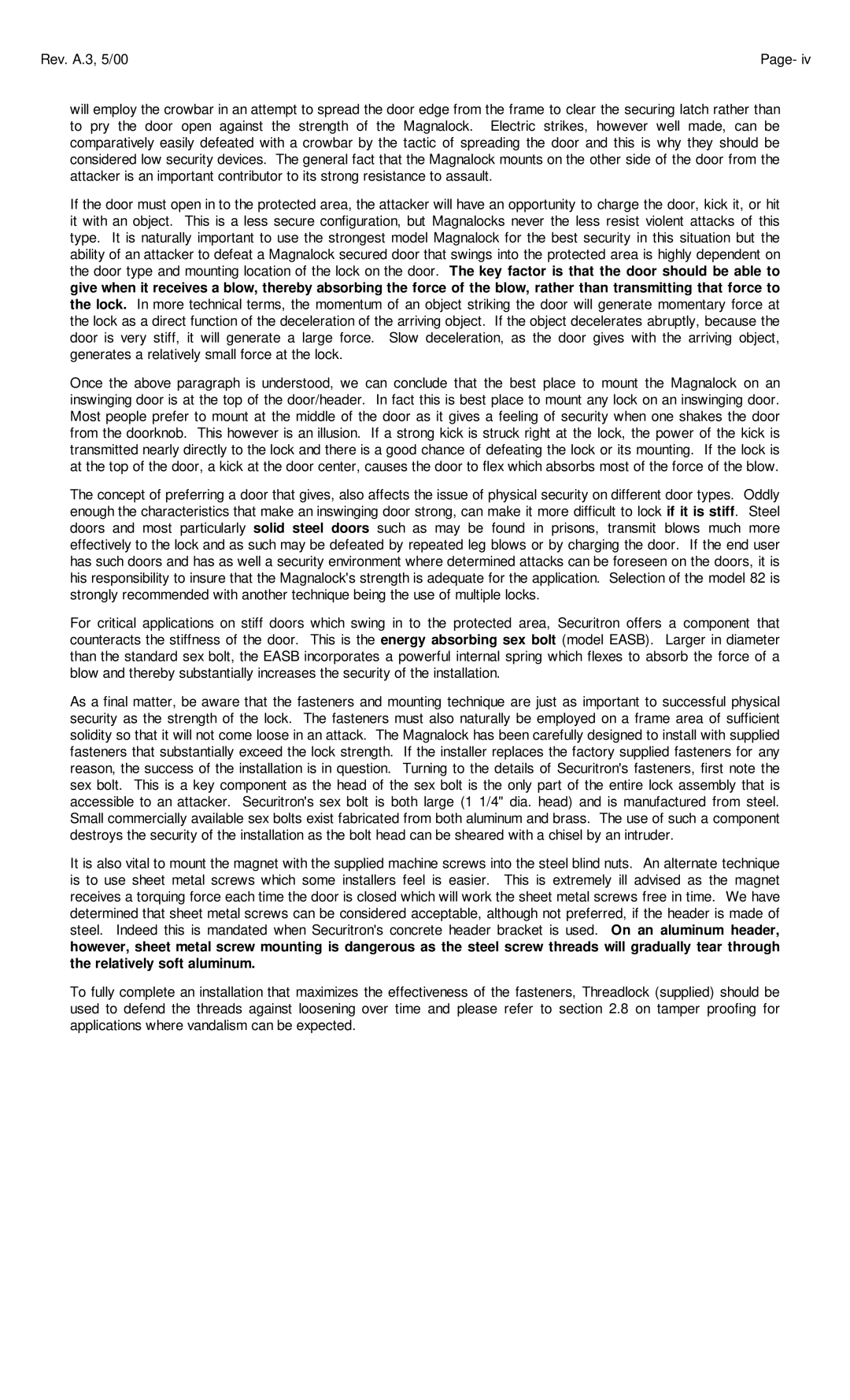Rev. A.3, 5/00 | Page- iv |
will employ the crowbar in an attempt to spread the door edge from the frame to clear the securing latch rather than to pry the door open against the strength of the Magnalock. Electric strikes, however well made, can be comparatively easily defeated with a crowbar by the tactic of spreading the door and this is why they should be considered low security devices. The general fact that the Magnalock mounts on the other side of the door from the attacker is an important contributor to its strong resistance to assault.
If the door must open in to the protected area, the attacker will have an opportunity to charge the door, kick it, or hit it with an object. This is a less secure configuration, but Magnalocks never the less resist violent attacks of this type. It is naturally important to use the strongest model Magnalock for the best security in this situation but the ability of an attacker to defeat a Magnalock secured door that swings into the protected area is highly dependent on the door type and mounting location of the lock on the door. The key factor is that the door should be able to give when it receives a blow, thereby absorbing the force of the blow, rather than transmitting that force to the lock. In more technical terms, the momentum of an object striking the door will generate momentary force at the lock as a direct function of the deceleration of the arriving object. If the object decelerates abruptly, because the door is very stiff, it will generate a large force. Slow deceleration, as the door gives with the arriving object, generates a relatively small force at the lock.
Once the above paragraph is understood, we can conclude that the best place to mount the Magnalock on an inswinging door is at the top of the door/header. In fact this is best place to mount any lock on an inswinging door. Most people prefer to mount at the middle of the door as it gives a feeling of security when one shakes the door from the doorknob. This however is an illusion. If a strong kick is struck right at the lock, the power of the kick is transmitted nearly directly to the lock and there is a good chance of defeating the lock or its mounting. If the lock is at the top of the door, a kick at the door center, causes the door to flex which absorbs most of the force of the blow.
The concept of preferring a door that gives, also affects the issue of physical security on different door types. Oddly enough the characteristics that make an inswinging door strong, can make it more difficult to lock if it is stiff. Steel doors and most particularly solid steel doors such as may be found in prisons, transmit blows much more effectively to the lock and as such may be defeated by repeated leg blows or by charging the door. If the end user has such doors and has as well a security environment where determined attacks can be foreseen on the doors, it is his responsibility to insure that the Magnalock's strength is adequate for the application. Selection of the model 82 is strongly recommended with another technique being the use of multiple locks.
For critical applications on stiff doors which swing in to the protected area, Securitron offers a component that counteracts the stiffness of the door. This is the energy absorbing sex bolt (model EASB). Larger in diameter than the standard sex bolt, the EASB incorporates a powerful internal spring which flexes to absorb the force of a blow and thereby substantially increases the security of the installation.
As a final matter, be aware that the fasteners and mounting technique are just as important to successful physical security as the strength of the lock. The fasteners must also naturally be employed on a frame area of sufficient solidity so that it will not come loose in an attack. The Magnalock has been carefully designed to install with supplied fasteners that substantially exceed the lock strength. If the installer replaces the factory supplied fasteners for any reason, the success of the installation is in question. Turning to the details of Securitron's fasteners, first note the sex bolt. This is a key component as the head of the sex bolt is the only part of the entire lock assembly that is accessible to an attacker. Securitron's sex bolt is both large (1 1/4" dia. head) and is manufactured from steel. Small commercially available sex bolts exist fabricated from both aluminum and brass. The use of such a component destroys the security of the installation as the bolt head can be sheared with a chisel by an intruder.
It is also vital to mount the magnet with the supplied machine screws into the steel blind nuts. An alternate technique is to use sheet metal screws which some installers feel is easier. This is extremely ill advised as the magnet receives a torquing force each time the door is closed which will work the sheet metal screws free in time. We have determined that sheet metal screws can be considered acceptable, although not preferred, if the header is made of steel. Indeed this is mandated when Securitron's concrete header bracket is used. On an aluminum header, however, sheet metal screw mounting is dangerous as the steel screw threads will gradually tear through the relatively soft aluminum.
To fully complete an installation that maximizes the effectiveness of the fasteners, Threadlock (supplied) should be used to defend the threads against loosening over time and please refer to section 2.8 on tamper proofing for applications where vandalism can be expected.
